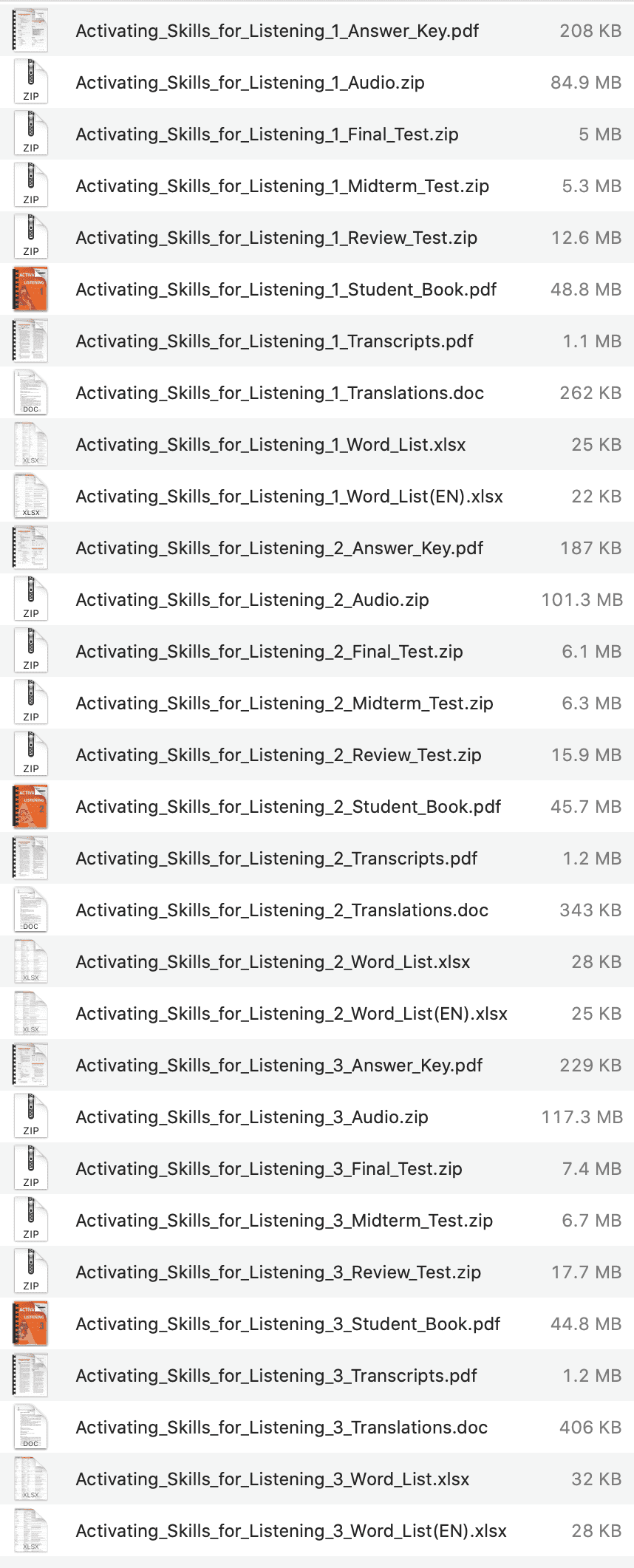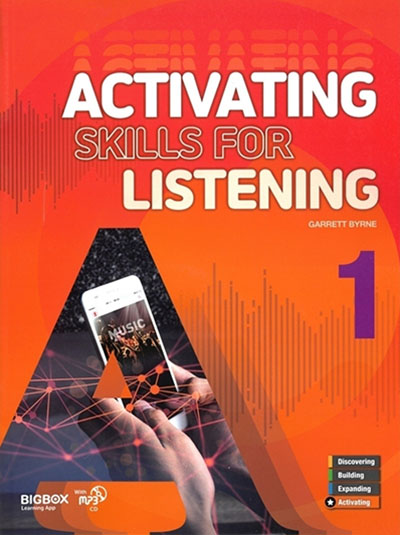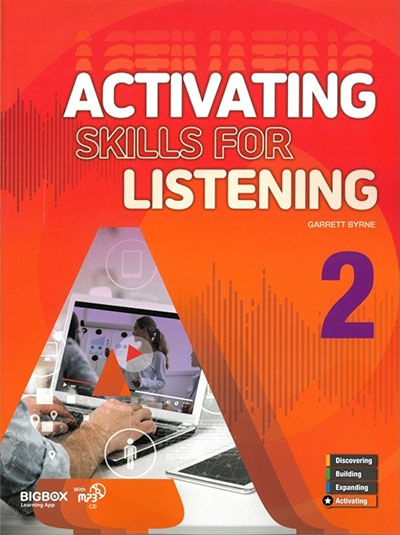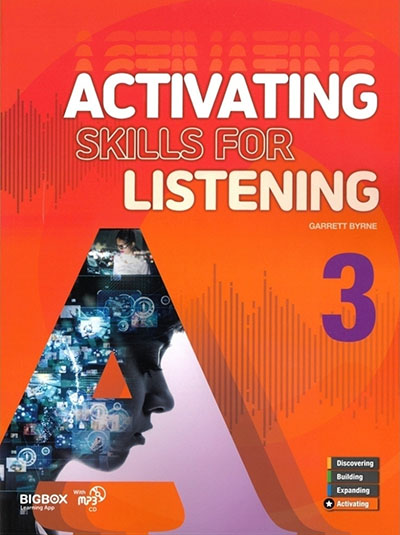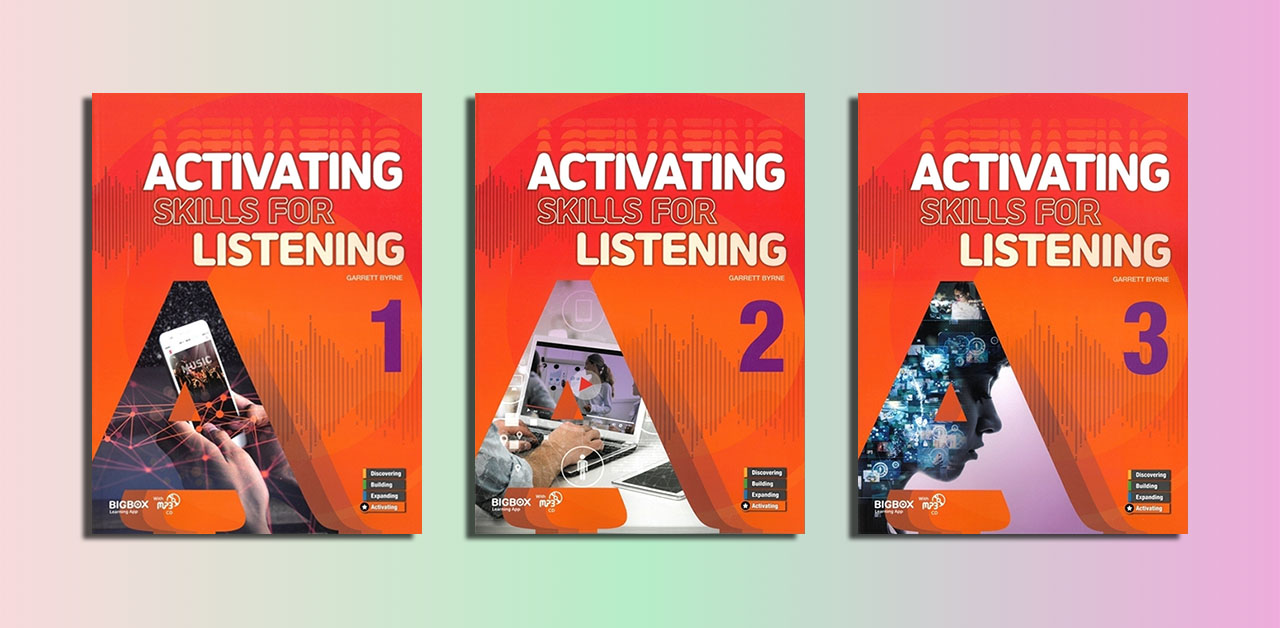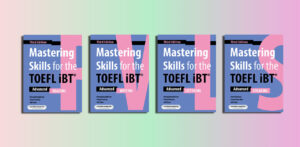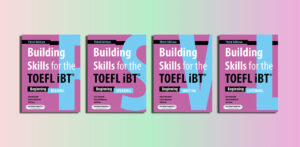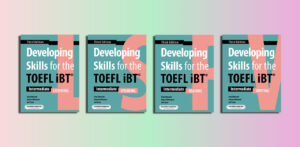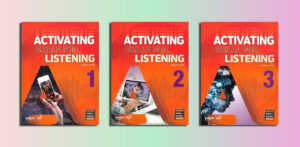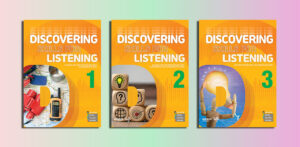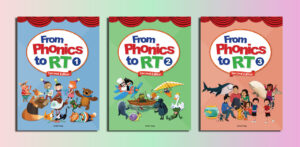Download, Compass, Online iTools
Download Activating Skills for Listening Pdf Resources (A2 / B1)
Activating Skills for Listening (PDFs Resources)
Level 1 (A2)
Activating Skills for Listening 1 Student’s Book.pdf – Sample: Click
Answer Key – Audio – Final Test – Midterm Test – Review Test – Student Book – Transcripts – Translations – Word List
Level 2 (A2+)
Activating Skills for Listening 2 Student’s Book.pdf – Sample: Click
Answer Key – Audio – Final Test – Midterm Test – Review Test – Student Book – Transcripts – Translations – Word List
Level 3 (B1)
Activating Skills for Listening 3 Student’s Book.pdf – Sample: Click
Answer Key – Audio – Final Test – Midterm Test – Review Test – Student Book – Transcripts – Translations – Word List
Discovering Skills for Listening (Pre A1 / A1): Click here
Building Skills for Listening (Pre A1 / A1): Click here
Expanding Skills for Listening (A1 / A2): Click here
Activating Skills for Listening (A2 / B1): Click here
Overview of the “Activating Skills for Listening” by Compass Publishing
Contents
- 1 Overview of the “Activating Skills for Listening” by Compass Publishing
- 2 Who is suitable for “Activating Skills for Listening”?
- 3 The benefits of “Activating Skills for Listening”
- 4 Effective learning strategies for “Activating Skills for Listening”
- 5 Effective teaching strategies for “Activating Skills for Listening”
| ✅ Coursebook: | Activating Skills for Listening |
| ✅ Publisher: | Compass Publishing |
| ✅ Authors: | Garrett Bryne |
| ✅ 7 Levels: | A2, A2+, B1 |
| ✅ Skills: | Listening |
| ✅ For: | Primary School, Junior High School |
| ✅ Publication year: | 2020 |
The Activating Skills for Listening series by Compass Publishing is a dynamic three-level English language teaching (ELT) resource crafted for young learners seeking to master listening comprehension. Aligned with CEFR levels A2, A2+, and B1, this series equips students with the skills to navigate real-world conversations with native speakers and excel in standardized tests like TOEFL Junior or IELTS. With engaging content, authentic audio, and progressive exercises, it’s an ideal tool for classrooms, language institutes, and self-study. This overview explores the key features of Level 1 (A2), Level 2 (A2+), and Level 3 (B1).
Series Overview
Designed for young English learners, Activating Skills for Listening focuses on developing listening fluency through topic-based units, interactive exercises, and high-quality audio materials. Published by Compass Publishing, a trusted name in ELT, the series aligns with the Common European Framework of Reference for Languages (CEFR), ensuring a clear progression from elementary to intermediate proficiency. Each level builds on the previous, preparing students for both everyday communication with native speakers and the listening components of standardized tests. Audio tracks, available on Compass Publishing’s SoundCloud, feature native-level speech to enhance pronunciation, intonation, and comprehension.
Level 1: A2 (Elementary to Pre-Intermediate)
Activating Skills for Listening 1 targets CEFR A2 learners, laying a strong foundation for listening comprehension. It introduces students to everyday topics such as family, school, daily routines, and hobbies through short, clear dialogs and monologs. Exercises focus on recognizing basic vocabulary, phrases, and simple instructions, helping learners identify main ideas in slow-paced, clear speech. Supported by audio tracks, likely accessible via SoundCloud, this level features native speakers, helping students build confidence in understanding authentic English. It’s perfect for beginners transitioning to intermediate proficiency and preparing for early tests like TOEFL Primary.
Level 2: A2+ (Upper Pre-Intermediate)
Activating Skills for Listening 2 advances to CEFR A2+, introducing moderately complex conversations in practical contexts like shopping, travel, and social interactions. Longer dialogs, slightly faster speech, and varied accents challenge students to deepen their listening skills. Exercises such as gap-fills, multiple-choice questions, and detail-oriented tasks help learners identify specific information and follow short narratives. Audio materials, likely on SoundCloud, support practice with dynamic speech patterns. This level is ideal for learners bridging the gap to intermediate fluency and preparing for intermediate-level standardized tests.
Level 3: B1 (Intermediate)
Activating Skills for Listening 3 caters to CEFR B1 learners, focusing on advanced listening skills for native-level conversations and academic or test-related scenarios. Covering broader topics like education, work, and current events, it features extended dialogs, lectures, and interviews. Exercises like note-taking, summarizing, and comprehension questions align with standardized test formats, such as TOEFL Junior or IELTS listening sections. Students develop skills in detailed comprehension, identifying speaker intent, and understanding varied speech patterns, including different accents and natural pacing. Audio resources provide authentic, native-level speech, making this level perfect for learners aiming for fluency and test success.
Conclusion
The Activating Skills for Listening series by Compass Publishing offers young English learners a clear path from CEFR A2 to B1 proficiency. From building foundational skills at Level 1, enhancing fluency at Level 2, to mastering advanced comprehension at Level 3, the series provides engaging, audio-supported content that prepares students for real-world communication and standardized tests. Educators and learners seeking a reliable, progressive listening resource will find this series an essential addition to their ESL/EFL toolkit.
Activating Skills for Listening 1
Who is suitable for “Activating Skills for Listening”?
The Activating Skills for Listening series by Compass Publishing is suitable for the following groups:
Young English Learners:
- Age Group: Primarily designed for children and teenagers learning English as a second or foreign language (ESL/EFL).
- Skill Level: Learners at CEFR levels A2 (Elementary to Pre-Intermediate), A2+ (Upper Pre-Intermediate), and B1 (Intermediate), corresponding to beginners transitioning to intermediate proficiency.
Students Preparing for Standardized Tests:
- Ideal for those preparing for tests with listening components, such as TOEFL Primary, TOEFL Junior, or IELTS, as the series includes exercises that mirror test formats (e.g., multiple-choice, gap-fills, note-taking).
- Particularly suited for students aiming to improve listening skills for academic and test-related scenarios.
Classroom Learners:
- Suitable for use in school or language institute settings, where teachers can integrate the series’ topic-based units, audio materials, and exercises into structured lessons.
- Supported by teacher guides and answer keys, making it practical for group instruction.
Self-Study Learners:
- Appropriate for motivated students studying independently, as the series includes clear exercises and audio materials (available on Compass Publishing’s SoundCloud) for practice without direct supervision.
- Learners Seeking Real-World Communication Skills:
- Designed for those who want to understand native-level conversations, covering everyday topics (e.g., family, school, shopping) at lower levels and broader themes (e.g., education, work, current events) at higher levels.
- Helps build confidence in understanding varied speech patterns, accents, and natural pacing.
Level-Specific Suitability:
- Level 1 (A2): Beginners needing foundational listening skills for simple conversations and early test preparation.
- Level 2 (A2+): Learners progressing toward intermediate fluency, ready for moderately complex conversations and intermediate test prep.
- Level 3 (B1): Intermediate learners aiming for fluency in native-level and academic contexts, preparing for advanced standardized tests.
Summary: The series is best suited for young ESL/EFL learners at CEFR A2 to B1 levels, whether in classrooms or self-study, who are focused on improving listening skills for real-world communication and standardized tests. Its engaging content and audio support make it accessible and effective for both guided and independent learning.
Activating Skills for Listening 2
The benefits of “Activating Skills for Listening”
The Activating Skills for Listening series by Compass Publishing offers numerous benefits for young English learners at CEFR levels A2 to B1. Below are the key advantages:
Enhanced Listening Comprehension:
- Develops skills to understand native-level speech through authentic audio tracks featuring varied accents, intonation, and natural pacing.
- Progresses from simple dialogs (Level 1) to complex conversations and lectures (Level 3), building confidence in real-world listening.
Alignment with CEFR Levels:
- Structured progression across A2, A2+, and B1 ensures learners advance systematically from beginner to intermediate proficiency.
- Tailored content matches learners’ skill levels, making it accessible and challenging at each stage.
Preparation for Standardized Tests:
- Exercises like gap-fills, multiple-choice questions, note-taking, and summarizing align with formats used in TOEFL Primary, TOEFL Junior, and IELTS listening sections.
- Helps students excel in academic and test-related listening tasks.
Engaging and Relevant Content:
- Topic-based units cover relatable themes (e.g., family, school, shopping at lower levels; education, work, current events at higher levels), keeping learners motivated.
- Interactive exercises maintain engagement for young learners in classroom or self-study settings.
Authentic Audio Resources:
- High-quality audio, likely accessible via Compass Publishing’s SoundCloud, exposes learners to native speakers, improving pronunciation and comprehension.
- Varied speech patterns and accents prepare students for diverse real-world interactions.
Flexibility for Classroom and Self-Study:
- Teacher guides and answer keys support structured classroom instruction.
- Clear exercises and audio access make it ideal for independent learners seeking self-paced practice.
Development of Practical Communication Skills:
- Focuses on understanding main ideas, specific details, and speaker intent, equipping learners for everyday conversations with native speakers.
- Builds fluency in practical contexts like shopping, travel, and social interactions (Level 2) and academic scenarios (Level 3).
Progressive Skill Building:
- Level 1 establishes foundational skills with simple vocabulary and instructions.
- Level 2 introduces moderately complex conversations for deeper comprehension.
- Level 3 enhances advanced skills like summarizing and interpreting extended dialogs or lectures.
Summary: The series enhances listening fluency, prepares learners for standardized tests, and builds practical communication skills through engaging, audio-supported content. Its CEFR-aligned structure and flexibility make it an effective tool for young ESL/EFL learners in both classroom and self-study environments, fostering confidence and proficiency in real-world English.
Activating Skills for Listening 3
Effective learning strategies for “Activating Skills for Listening”
To maximize the benefits of the Activating Skills for Listening series by Compass Publishing, learners can adopt the following effective learning strategies tailored to its structure and content (CEFR levels A2 to B1). These strategies are designed for young ESL/EFL learners, whether in classroom settings or self-study, to enhance listening comprehension, test preparation, and real-world communication skills.
1. Active Listening with Audio Resources
Strategy: Engage actively with the audio tracks (likely available on Compass Publishing’s SoundCloud) by listening multiple times to each dialog, monolog, or lecture.
- First Listen: Focus on the general idea without looking at the text or exercises to build gist comprehension.
- Second Listen: Follow along with the transcript (if provided) to connect spoken words with written text, noting pronunciation and intonation.
- Third Listen: Answer comprehension questions or complete exercises (e.g., gap-fills, multiple-choice) to focus on specific details.
Why It Works: Repeated listening mimics real-world exposure to native speech, improving familiarity with accents, pacing, and vocabulary, which aligns with the series’ use of authentic audio.
Level-Specific Tip:
- Level 1 (A2): Focus on recognizing familiar words and simple phrases in slow, clear speech.
- Level 2 (A2+): Pay attention to slightly faster speech and varied accents in practical contexts like shopping or travel.
- Level 3 (B1): Practice identifying speaker intent and nuanced details in longer dialogs or lectures.
2. Pre-Listening Preparation
Strategy: Before listening, preview the topic-based unit (e.g., family, school, current events) and related vocabulary or phrases listed in the book.
- Brainstorm related words or predict the content of the audio to activate prior knowledge.
- Review any provided visuals or questions to set a purpose for listening.
Why It Works: Pre-listening builds context, making it easier to follow the audio and align with the series’ focus on relatable themes.
Level-Specific Tip:
- Level 1: Study basic vocabulary lists (e.g., family members, daily routines) to prepare for simple dialogs.
- Level 2: Anticipate conversational phrases used in shopping or travel scenarios.
- Level 3: Review academic or professional vocabulary for topics like education or work.
3. Practice with Progressive Exercises
Strategy: Complete the series’ exercises systematically to build skills progressively.
- Start with easier tasks (e.g., identifying main ideas) before moving to complex ones (e.g., summarizing or note-taking).
- Check answers using provided keys (or teacher feedback) and revisit incorrect responses to understand mistakes.
Why It Works: The series’ exercises, such as gap-fills, multiple-choice, and note-taking, are designed to mirror standardized test formats (e.g., TOEFL Junior, IELTS), reinforcing test-taking skills and detailed comprehension.
Level-Specific Tip:
- Level 1: Focus on multiple-choice questions to recognize key words and instructions.
- Level 2: Tackle gap-fills to improve attention to specific details in conversations.
- Level 3: Practice note-taking during lectures to prepare for academic and test scenarios.
4. Mimic Native Speech for Pronunciation and Intonation
Strategy: Use the audio tracks to shadow or repeat after native speakers.
- Pause the audio after short segments and mimic the speaker’s pronunciation, stress, and intonation.
- Record yourself and compare with the original audio to identify areas for improvement.
Why It Works: Shadowing enhances listening fluency and pronunciation, aligning with the series’ goal of preparing learners for native-level conversations.
Level-Specific Tip:
- Level 1: Repeat simple phrases to master basic sentence patterns.
- Level 2: Imitate conversational exchanges to improve natural speech flow.
- Level 3: Mimic longer sentences or lecture excerpts to refine intonation in complex speech.
5. Integrate Contextual Practice
Strategy: Apply listening skills to real-world contexts outside the series.
- Supplement with English media (e.g., podcasts, videos, or songs) related to the unit topics (e.g., family, travel, education).
- Practice summarizing or discussing what you heard with peers, teachers, or in a journal.
Why It Works: Connecting the series’ topics to real-world content reinforces comprehension and builds confidence in practical communication, a key goal of the series.
Level-Specific Tip:
- Level 1: Watch simple English cartoons about daily life to reinforce unit themes.
- Level 2: Listen to short travel vlogs or podcasts to practice conversational listening.
- Level 3: Engage with news clips or academic talks to align with advanced topics.
6. Regular Review and Spaced Repetition
Strategy: Revisit completed units periodically to reinforce learning.
- Use spaced repetition (e.g., review after 1 day, 1 week, 1 month) to solidify vocabulary and comprehension skills.
- Re-listen to audio tracks and redo exercises to track progress.
Why It Works: The series’ progressive structure benefits from regular review to ensure retention of skills across CEFR levels.
Level-Specific Tip:
- Level 1: Review basic vocabulary and simple dialogs weekly.
- Level 2: Revisit complex conversations biweekly to retain new phrases.
- Level 3: Periodically practice summarizing lectures to maintain advanced skills.
7. Collaborative Learning (Classroom Settings)
Strategy: In classroom settings, engage in group activities to enhance listening skills.
- Pair up to discuss audio content or role-play dialogs based on unit topics.
- Use teacher guides to participate in guided discussions or group comprehension tasks.
Why It Works: The series supports classroom use with teacher resources, and collaborative activities reinforce listening through peer interaction.
Level-Specific Tip:
- Level 1: Role-play simple scenarios like introducing family members.
- Level 2: Discuss travel plans in pairs to practice conversational listening.
- Level 3: Debate current events topics to deepen comprehension and critical thinking.
8. Set Specific Goals and Track Progress
Strategy: Set clear, measurable goals for each level and track improvement.
- Example Goals: “Understand 80% of Level 1 dialogs without a transcript” or “Complete Level 3 note-taking exercises with 90% accuracy.”
- Use a journal or app to log completed units, scores on exercises, and areas of difficulty.
Why It Works: Goal-setting aligns with the series’ structured progression and motivates learners to stay consistent.
Level-Specific Tip:
- Level 1: Aim to recognize key words in every dialog.
- Level 2: Target understanding specific details in 90% of conversations.
- Level 3: Focus on summarizing lectures accurately for test readiness.
Summary
By combining active listening, pre-listening preparation, progressive exercise practice, shadowing, contextual application, spaced repetition, collaborative learning, and goal-setting, learners can effectively use the Activating Skills for Listening series to improve listening comprehension, prepare for standardized tests, and gain confidence in real-world English communication. Tailoring these strategies to the specific CEFR level (A2, A2+, B1) ensures alignment with the series’ structure and maximizes learning outcomes for young ESL/EFL learners.
Effective teaching strategies for “Activating Skills for Listening”
To effectively teach the Activating Skills for Listening series by Compass Publishing (CEFR levels A2 to B1) in classroom or language institute settings, educators can implement the following strategies. These are tailored for young ESL/EFL learners to maximize listening comprehension, engagement, and preparation for real-world communication and standardized tests like TOEFL Primary, TOEFL Junior, or IELTS. The strategies leverage the series’ topic-based units, authentic audio (likely on Compass Publishing’s SoundCloud), and teacher resources.
1. Scaffolded Lesson Planning
Strategy: Structure lessons around the series’ progressive units, using a clear scaffolded approach: pre-listening, while-listening, and post-listening activities.
- Pre-Listening: Introduce the unit’s topic (e.g., family, travel, education) with brainstorming, visuals, or vocabulary exercises to activate prior knowledge.
- While-Listening: Play audio tracks and guide students through exercises (e.g., multiple-choice, gap-fills) to focus on main ideas or specific details.
- Post-Listening: Discuss answers, clarify misunderstandings, and extend learning with role-plays or discussions tied to the topic.
Why It Works: The series’ structure supports scaffolding, aligning with CEFR levels (A2, A2+, B1) to build skills progressively while keeping learners engaged.
Level-Specific Tip:
- Level 1 (A2): Use visuals (e.g., flashcards of family members) to pre-teach vocabulary and focus on simple dialogs.
- Level 2 (A2+): Introduce conversational phrases for shopping or travel and use gap-fills to target details.
- Level 3 (B1): Pre-teach academic vocabulary and guide note-taking during lectures for advanced comprehension.
2. Leverage Authentic Audio Actively
Strategy: Use the series’ audio tracks to create immersive listening experiences.
- Play audio multiple times: first for gist, then for details, and finally for targeted exercises.
- Pause audio at key moments to ask predictive questions (e.g., “What will the speaker say next?”) or clarify pronunciation and intonation.
- Encourage students to mimic native speakers’ speech patterns after listening.
Why It Works: The series’ authentic audio, featuring native-level speech and varied accents, prepares students for real-world communication and test scenarios.
Level-Specific Tip:
- Level 1: Play short dialogs slowly, pausing to highlight key words or phrases.
- Level 2: Use moderately complex conversations, pausing to discuss unfamiliar expressions.
- Level 3: Play extended lectures, pausing to model note-taking or summarize key points.
3. Incorporate Interactive Group Activities
Strategy: Use pair or group activities to reinforce listening skills and foster collaboration.
- Assign roles (e.g., one student listens for main ideas, another for details) during audio playback, then have them share findings.
- Create role-plays or simulations based on unit topics (e.g., a shopping scenario for Level 2).
- Use teacher guides to facilitate group discussions or debates, especially for Level 3 topics like current events.
Why It Works: The series supports classroom use with teacher resources, and interactive activities align with its engaging, topic-based content, boosting motivation and peer learning.
Level-Specific Tip:
- Level 1: Pair students to practice simple introductions or routines from dialogs.
- Level 2: Organize group role-plays of travel scenarios to practice conversational listening.
- Level 3: Facilitate small-group debates on education or work-related topics to deepen comprehension.
4. Align Exercises with Test Preparation
Strategy: Use the series’ exercises (e.g., multiple-choice, gap-fills, note-taking) to teach test-taking strategies for TOEFL Primary, TOEFL Junior, or IELTS.
- Teach students to predict answers before listening, scan questions quickly, and manage time effectively.
- Provide practice with timed exercises to simulate test conditions.
- Review answers collectively, discussing why certain options are correct to build critical thinking.
Why It Works: The series’ exercises mirror standardized test formats, making it an ideal tool for test preparation while reinforcing listening skills.
Level-Specific Tip:
- Level 1: Focus on multiple-choice questions to teach identifying key words in simple instructions.
- Level 2: Practice gap-fills to improve attention to specific details under time constraints.
- Level 3: Use note-taking tasks to prepare for lecture-based test sections.
5. Differentiate Instruction for Diverse Learners
Strategy: Adapt activities to accommodate varied proficiency levels and learning styles within the classroom.
- For struggling learners, simplify tasks (e.g., focus on fewer questions or provide transcripts for Level 1).
- For advanced learners, add challenges (e.g., summarize audio without transcripts or create their own dialogs for Level 3).
- Use visuals, gestures, or written summaries to support visual and kinesthetic learners.
Why It Works: The series’ CEFR-aligned structure allows flexibility to meet diverse needs, ensuring all students progress toward fluency.
Level-Specific Tip:
- Level 1: Provide word banks for beginners to support vocabulary recognition.
- Level 2: Offer optional challenges like rewriting dialogs for stronger students.
- Level 3: Assign advanced students to lead discussions or summarize lectures.
6. Integrate Technology and Supplementary Resources
Strategy: Enhance lessons with technology and external resources to complement the series’ audio and exercises.
- Use interactive whiteboards or apps to display transcripts or visuals while playing audio.
- Supplement with online videos, podcasts, or songs related to unit topics (e.g., travel vlogs for Level 2, news clips for Level 3).
- Encourage students to access audio tracks on SoundCloud for extra practice at home.
Why It Works: Technology increases engagement, and supplementary materials reinforce the series’ focus on real-world communication.
Level-Specific Tip:
- Level 1: Show animated videos about daily routines to reinforce simple vocabulary.
- Level 2: Use short travel podcasts to extend listening practice.
- Level 3: Incorporate academic TED Talks to align with advanced topics.
7. Provide Regular Feedback and Assessment
Strategy: Use the series’ answer keys and teacher guides to provide constructive feedback and track progress.
- Review exercise answers in class, discussing common errors and strategies for improvement.
- Conduct periodic assessments (e.g., mock listening tests) to measure growth in comprehension and test readiness.
- Encourage self-assessment by having students reflect on their listening challenges and progress.
Why It Works: Feedback reinforces learning and aligns with the series’ goal of preparing students for tests and real-world communication.
Level-Specific Tip:
- Level 1: Give feedback on recognizing key words and basic comprehension.
- Level 2: Focus on accuracy in identifying details and conversational phrases.
- Level 3: Provide feedback on summarizing and interpreting complex audio.
8. Foster a Communicative Classroom Environment
Strategy: Create a supportive environment where students feel confident practicing listening and speaking skills.
- Encourage active participation by praising efforts and creating low-pressure opportunities to respond to audio content.
- Use pair or group discussions to connect listening tasks to speaking practice, reinforcing unit topics.
- Incorporate fun activities like listening games (e.g., “spot the word” for Level 1) to maintain engagement.
Why It Works: A communicative approach aligns with the series’ focus on real-world fluency and keeps young learners motivated.
Level-Specific Tip:
- Level 1: Play listening games to identify familiar words in dialogs.
- Level 2: Encourage pair discussions about travel or shopping scenarios.
- Level 3: Facilitate group presentations summarizing lecture content.
Summary
Effective teaching strategies for the Activating Skills for Listening series include scaffolded lesson planning, active use of authentic audio, interactive group activities, test-aligned exercises, differentiated instruction, technology integration, regular feedback, and a communicative classroom environment. By tailoring these strategies to the series’ CEFR levels (A2, A2+, B1), educators can enhance young learners’ listening comprehension, prepare them for standardized tests, and build confidence in real-world English communication. The series’ resources, including audio tracks and teacher guides, support these strategies for both classroom engagement and skill development.

